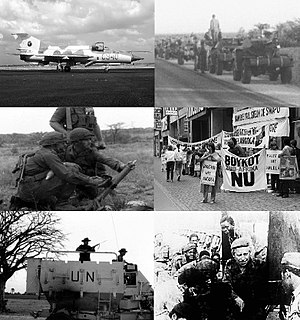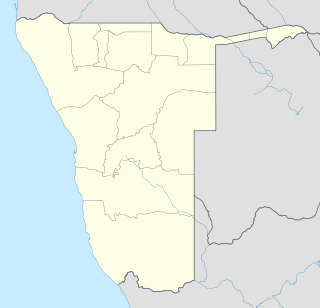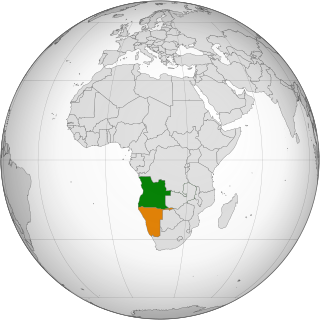Related Research Articles

The Angolan Civil War was a civil war in Angola, beginning in 1975 and continuing, with interludes, until 2002. The war began immediately after Angola became independent from Portugal in November 1975. The war was a power struggle between two former anti-colonial guerrilla movements, the communist People's Movement for the Liberation of Angola (MPLA) and the anti-communist National Union for the Total Independence of Angola (UNITA). The war was used as a surrogate battleground for the Cold War by rival states such as the Soviet Union, Cuba, South Africa and the United States.

The Battle of Cuito Cuanavale was fought intermittently between 14 August 1987 and 23 March 1988, south and east of the town of Cuito Cuanavale, Angola, by the People's Armed Forces for the Liberation of Angola (FAPLA), Cuba, apartheid South Africa, and insurgents of the National Union for the Total Independence of Angola (UNITA) during the Angolan Civil War and South African Border War. The battle was the largest engagement of the Angolan conflict and the biggest conventional battle on the African continent since World War II. UNITA and its South African allies defeated a major FAPLA offensive towards Mavinga, preserving the former's control of southern Angola. They proceeded to launch a bloody but inconclusive counteroffensive on FAPLA defensive positions around the Tumpo River east of Cuito Cuanavale.

The United Nations Angola Verification Mission II, established May 1991 and lasting until February 1995, was the second United Nations peacekeeping mission, of a total of four, deployed to Angola during the course of the Angolan Civil War, the longest war in modern African history. Specifically, the mission was established to oversee and maintain the multilateral ceasefire of 1990 and the subsequent Bicesse Accords in 1991, which instituted an electoral process for the first time including the two rival factions of the civil war, the People's Movement for the Liberation of Angola (MPLA), the de facto government of Angola, with control of Luanda and most of the country since independence in 1975, and the National Union for the Total Independence of Angola (UNITA).

The Namibian war of independence, also known as the Angolan bush war, and sometimes denoted in South Africa as the South African border war, was a largely asymmetric conflict that occurred in Namibia, Zambia, and Angola from 26 August 1966 to 21 March 1990. It was fought between the South African Defence Force (SADF) and the People's Liberation Army of Namibia (PLAN), an armed wing of the South West African People's Organisation (SWAPO). The South African Border War resulted in some of the largest battles on the African continent since World War II and was closely intertwined with the Angolan Civil War.

Operation Savannah was the South African code name for their military incursion into Angola in 1975–1976. In Angola, these actions were known as the 1975–1976 South African Invasion and the Luanda Conquest Campaign. It was part of the South African Border War and arose due to the Angolan War of Independence. The operation also materially influenced the subsequent Angolan Civil War. South African forces invaded deep into Angola with the objective of driving the MPLA, Soviet and Cuban forces out of southern Angola so as to strengthen the position of UNITA, the main opponent of the MPLA and an ally of South Africa.

Operation Askari was a military operation during 1983 in Angola by the South African Defence Force (SADF) during the South African Border War.

Operation Displace was a military operation by the South African Defence Force during the South African Border War and Angolan Civil War. It involved maintaining the illusion that the SADF had remained in brigade strength east of Cuito Cuanavale at the end of April 1988 and the eventual withdrawal of all South African military units from south-eastern Angola during August 1988.

Operation Wallpaper was a military operation by the South African Defence Force (SADF) during the Angolan Civil War and South African Border War.

Operation Hooper was a military operation in 1987-88 by the South African Defence Force (SADF) during the South African Border War. This operation forms part of what has come to be called the Battle of Cuito Cuanavale. The Cubans' objective was securing the town of Cuito Cuanavale on the west of the river from capture. The SADF objective was to drive the People's Armed Forces for the Liberation of Angola (FAPLA) west across the river or to destroy them, so as to ensure that FAPLA was no longer a threat to the National Union for the Total Independence of Angola (UNITA) in the south-east. The FAPLA advance was permanently halted, UNITA lived to fight on for another 15 years. The SADF never attempted to capture the town. Both sides claimed victory.

Operation Prone was a proposed military operation by the South African Defence Force (SADF) and South West African Territorial Force (SWATF) during the South African Border War and Angolan Civil War between May and September 1988. With the advance of the 50th Cuban Division towards Calueque and the South-West Africa border, the SADF formed the 10 SA Division to counter this threat. The plan for Operation Prone had two phases. Operation Linger was to be a counterinsurgency phase and Operation Pact a conventional phase.

The United Nations Transition Assistance Group (UNTAG) was a United Nations (UN) peacekeeping force deployed from April 1989 to March 1990 in Namibia to monitor the peace process and elections there. Namibia had been occupied by South Africa since 1915, first under a League of Nations mandate and later illegally. Since 1966, South African forces had been combating an insurgency by the People's Liberation Army of Namibia (PLAN), the military wing of the Namibian-nationalist South West African People's Organization (SWAPO). The UN Security Council passed Resolution 435 in 1978, which set out a plan for elections administered by South Africa but under UN supervision and control after a ceasefire. However, only in 1988 were the two parties able to agree to a ceasefire. As UNTAG began to deploy peacekeepers, military observers, police, and political workers, hostilities were briefly renewed on the day the transition process was supposed to begin. After a new round of negotiations, a second date was set and the elections process began in earnest. Elections for the constitutional assembly took place in November 1989. They were peaceful and declared free and fair; SWAPO won a majority of the seats. The new constitution was adopted four months later and it was followed by Namibia's official independence and the successful conclusion of UNTAG.
The Agreement among the People's Republic of Angola, the Republic of Cuba, and the Republic of South Africa granted independence to Namibia from South Africa and ended the direct involvement of foreign troops in the Angolan Civil War. The accords were signed on 22 December 1988 at the United Nations Headquarters in New York City by the Foreign Ministers of People's Republic of Angola, Republic of Cuba and Republic of South Africa.

Angola–South Africa relations refer to the current and historical relationship between Angola and South Africa. Relations in the post-apartheid era are quite strong as the ruling parties in both states, the African National Congress in South Africa and the MPLA in Angola, fought together during the Angolan Civil War and South African Border War. They fought against UNITA rebels, based in Angola, and the apartheid-era government in South Africa which supported them. Nelson Mandela mediated between the MPLA and UNITA during the final years of the Angolan Civil War. Although South Africa was preponderant in terms of relative capabilities during the late twentieth century, the recent growth of Angola has led to a more balanced relation.

The Cuban intervention in Angola began on 5 November 1975, when Cuba sent combat troops in support of the communist-aligned People's Movement for the Liberation of Angola (MPLA) in against the pro-western National Union for the Total Independence of Angola (UNITA) and National Liberation Front of Angola (FNLA). The intervention came after the outbreak of the Angolan Civil War, which occurred after the former Portuguese colony was granted independence after the Angolan War of Independence. The civil war quickly became a proxy war between the Eastern Bloc led by the Soviet Union and the Western Bloc led by the United States. South Africa and the United States backed UNITA and the FNLA, while communist nations backed the MPLA. 4,000 Cuban troops helped to turn back a three-pronged advance by the SADF and Zairean troops, backed up by foreign mercenaries. Later, 18,000 Cuban troops defeated the FNLA in the north and UNITA in the south. Separatists from the Front for the Liberation of the Enclave of Cabinda (FLEC) fought the Cubans but were defeated. In 1976, the Cuban military in Angola reached 36,000 troops. Following the withdrawal of Zaire and South Africa, Cuban forces remained in Angola to support the MPLA government against UNITA in the continuing civil war. South Africa spent the following decade launching bombing and strafing raids from its bases in South West Africa into southern Angola, while UNITA engaged in ambushes, hit-and-run attacks, and harassment of Cuban units.
The Brazzaville Protocol mandated the withdrawal of Cuban troops from Angola, paving the way for Namibia's independence through the New York Accords. Representatives from the governments of Angola, Cuba, and South Africa signed the protocol on December 13, 1988 in Brazzaville, Congo.

The People's Armed Forces of Liberation of Angola or FAPLA was originally the armed wing of the People's Movement for the Liberation of Angola (MPLA) but later (1975–1991) became Angola's official armed forces when the MPLA took control of the government.

Angolan–Namibian relations relate to the relations between the governments of the Republic of Angola and the Republic of Namibia.

Operation Southern Cross (1986) was a military operation by the South African Defence Force during the South African Border War and Angolan Civil War.

Operation Merlyn was a military operation by the South African Defence Force (SADF), South West African Territorial Force (SWATF) and South West African Police (SWAPOL) during the South African Border War and Angolan Civil War in April 1989. The aim of the operation was to prevent the incursion of PLAN (SWAPO) insurgents into South West Africa/Namibia from bases in Angola. These incursions were in violation of a ceasefire which came into effect on 1 April 1989 via the implementation of United Nations Security Council Resolution 435 and the Tripartite Accord. Initially, these PLAN incursions were tackled by South West African police units and eventually by SADF and SWATF units, released to assist the police having been confined to their bases by the peace agreements. These incursions and the conflict that occurred ended after hastily arranged talks resulted in the Mount Etjo Declaration and an eventual ceasefire.

Operation Magneto was a military operation in August 1985 to transport UNITA soldiers by the South African Defence Force (SADF) during the Angolan Civil War and South African Border War.
References
- ↑ Ohlson, Thomas; Stephen John Stedman; Robert Davies (1994). The New Is Not Yet Born: Conflict Resolution in Southern Africa. pp. 98–99.
- 1 2 Scholtz, Leopold (2013). The SADF in the Border War 1966-1989. Cape Town: Tafelberg. ISBN 978-0-624-05410-8.